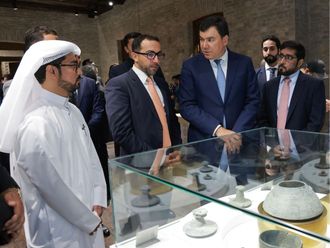Remains of some of the oldest elephants found in the Arabia region will be on display in Abu Dhabi later this year.
The exhibition will beld at the Environment Research and Wildlife Development Agency premises here.
The exhibits include a 2.54-metre long tusk, pieces of a skull and parts of jaws as well as ribs found in the western region of Abu Dhabi.
The fossils were discovered in the early 1990s by a team comprising members of the Natural History Museum in London as well as Yale University and scientists from the Abu Dhabi Islands Archaeological Survey (Adias).
A majority of the fossils date back to the late Miocene period, six to eight million years ago.
At that time, the climate was much wetter than it is today, and the landscape of the western region of Abu Dhabi was something like the modern day East African savannah – with trees and grassland areas and with large slow-moving rivers.
In addition to elephant fossils, researchers also discovered the remains of the ancient ancestors of gazelles, hippopotamuses, horses, birds, crocodiles, turtles and fish.
The exhibit will include only a few of the fossils discovered by the scientists, who covered an area stretching from Rumaitha, in the east, to beyond Jebel Dhanna, in the west, a distance of more than 150km.
In all, more than 8,000 fossils have been found, which in all make up one of the world's most important collections from this period.
A key feature of the exhibit will be a model of a late Miocene elephant created by Abdul Hafeez from the Taxidermy Unit of the Private Department of President His Highness Sheikh Zayed bin Sultan Al Nahyan.
British artist Gemma Larkin has been commissioned to produce a special painting of the late Miocene for the exhibit.
"We are extremely grateful to the department for collaborating with us on this important project," Peter Hellyer, Adias's executive director, said yesterday.
"Abdul Hafeez and Dr Mark Beech (Adias's senior resident archaeologist) have carefully worked together to produce the first scale model ever made of this primitive elephant species, Stegotetrabelodon syrticus, which, unlike today's elephants, had four and not two tusks."
"We hope the display will give Abu Dhabi residents an idea of what life was like here millions of years ago, and of the many animals which lived in the western region," Hellyer said.
Remains of ancient tuskers on display
Remains of some of the oldest elephants found in the Arabia region will be on display in Abu Dhabi later this year.












